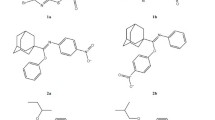Abstract
Similarity searching in the reaction and molecule domain is applied to the design and development of a hypothetical bioactive compound. Potential synthetic pathways are generated utilising reaction and molecule similarity features in REACCS. Lead optimisation of the target compound is made possible by similarity searches over a database of compounds of known activity and by subsequent manipulation of the results. It is shown that similarity searching can be used as a powerful, complementary tool in the design of new chemical compounds.
Access this chapter
Tax calculation will be finalised at checkout
Purchases are for personal use only
Preview
Unable to display preview. Download preview PDF.
Similar content being viewed by others
References
Similarity and Clustering in Chemical Information Systems: Willett, P.; Research Studies Press: Letchworth, 1987, and references therein.
Carhart, R.W.; Smith, D.H.; Venkatararghavan, R. ‘Atom Pairs as Molecular Features in Structure Activity Studies - Definition and Application’. J. Chem. Inf. Comput. Sci. 1985, 25, 64–73.
Nilakantan, R.; Bauman, N.; Dixon, J.; Venkataragharan, R. ‘Topological Torsion: A New Molecular Descriptor for SAS Applications. Comparison with other Descriptors’; J. Chem. Inf. Comput. Sci. 1987, 27, 82–85.
Sheridan, R.P.; Venkatarahvaran, R. ‘New Methods in Computer-aided Drug Design’. Acc. Chem. Res. 1987, 20, 322–329.
Willett, P.; Winterman, V.; Bawden, D. ‘Implementation of Non-hierarchic Cluster Analysis Methods in Chemical Information Systems: Selection of Compounds for Biological Testing and Clustering of Substructure Search Output’. J. Chem. Inf. Comput. Sci. 1986, 26, 109–118.
Vladutz, G. ‘Do We Still Need a Classification of Reactions?’. In Modern Approaches to Chemical Reaction Searching; Willett, P., Ed.; Gower: Aldershot, 1986, pp. 202–220.
Moock, T.E.; Grier, D.L.; Hounshell, W.D.; Grethe, G.; Cronin, K.; Nourse, J.G.; Theodosiou, J. ‘Similarity Searching in the Organic Reaction Domain’. Tetrahedron Comput. Methodol. 1988, 1, 117–128.
Author information
Authors and Affiliations
Editor information
Editors and Affiliations
Rights and permissions
Copyright information
© 1993 Springer-Verlag Berlin Heidelberg
About this paper
Cite this paper
Grethe, G., Hounshell, W.D. (1993). Similarity Searching in the Development of New Bioactive Compounds. An Application.. In: Warr, W.A. (eds) Chemical Structures 2. Springer, Berlin, Heidelberg. https://doi.org/10.1007/978-3-642-78027-1_35
Download citation
DOI: https://doi.org/10.1007/978-3-642-78027-1_35
Publisher Name: Springer, Berlin, Heidelberg
Print ISBN: 978-3-642-78029-5
Online ISBN: 978-3-642-78027-1
eBook Packages: Springer Book Archive




